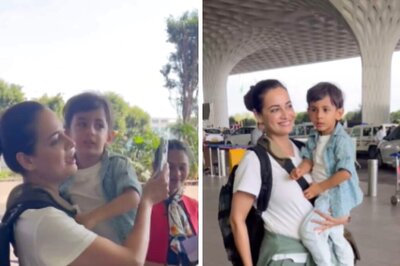
views
Pithoragarh/New Delhi: The bodies of seven mountaineers killed on the way to Nanda Devi East Peak in May were brought down Wednesday, ending an operation that involved ITBP climbers and IAF helicopters.
It took the ITBP team a total of 500 hours spanning over 15 days to bring the mortal remains back so that the families of the deceased find a closure of the tragic episode.
The bodies were flown to the Pithoragarh's Naini Saini airport in IAF helicopters in afternoon from a base camp at an altitude of 15,250 ft in the mountains, where a 15-member team of the ITBP climbers had brought them down on their shoulders from another base camp at 18,000 ft, said ITBP Director General SS Deswal.
The bodies of eight-member team of the climbers, comprising seven foreigners and one Indian, were first spotted by the IAF's search planes on June 3, days after they were reported missing on May 25.
Following detection of the bodies, lying partially buried in a terrain too difficult to be retrieved from in IAF's choppers, the ITBP launched its "daredevil" mission on June 13 and managed to reach them on foot after an "arduous" trekking and climbing operation.
They first brought the bodies to the first base camp at 18,000 ft and then to a second one at lower altitude.
From the second base camp, the bodies were first flown down to Munsiyari by helicopters and then taken to the Naini Saini airport in Pithoragarh by another IAF helicopter, District Magistrate VK Jogdande said.
The bodies will be taken to Medical College Haldwani for post-mortem and identification, he added.
While one of the mountaineers is still missing, the recovered seven bodies are being identified, said officials.
The dead include 4 from the UK, 2 from the United States of America and one each from Australia and India.
"We are still looking for the eighth mountaineer. It is expected that the body would be buried under snow and once it melts it could be retrieved," said the ITBP DG.
A little penguin doll, carabiners, ropes, foreign currency, mobile phones, passports, thermal clothing, climbing axe, water-resistant pouches, watches and a helmet was among the items that the rescue team retrieved from the bodies of the climbers, he said.
Praising his personnel for carrying out the successful "unprecedented" operation, the ITBP DG told reporters at the forces' headquarters in Delhi said that this was a unique and unprecedented operation as the force has never executed a retrieval mission at such a height in the Himalayas.
Praising the ITBP team, Deswal said the rescue team carried special equipment and deep sensors to retrieve the bodies.
This was an extraordinary operation given the vagaries of the weather, very difficult and inhospitable terrain but our team brought the bodies with all the respect due to the dead, he said.
The ITBP chief specifically praised his men, led by ace mountaineer and second-in-command rank officer Ratan Singh Sonal, for carrying the bodies on their shoulders and bringing them down to the base camps.
Deswal also also announced creation of five special rescue and relief teams of the force to undertake similar operations.
The teams will help trekkers and climbers when they undertake their journey in the Himalayan ranges from Ladakh in Jammu and Kashmir, to Uttarakhand, Himachal Pradesh, Sikkim and Arunachal Pradesh.
The mountain warfare trained force is tasked to guard the 3,488-km icy frontier with China.
"We welcome trekkers from the country and abroad to the India peaks. There has been an increase in expedition to the mountains. I assure them that we are there for any support and help," he said.
ITBP spokesperson Vivek Kumar Pandey said the teams launched the operation on June 14 and finish it successfully in about 500 hours.
A total of twelve mountaineers had initially set out on the expedition to this 7,434-metre-high Nanda Devi East peak but were reported missing on May 25.
Four trekkers were rescued in the initial phase.
The ill-fated expedition was led by well-known British mountaineer Martin Moran, who had scaled the peak twice.
The other members of the team are John Charles McLaren, Richard Payne and Rupert James Whewell (from the UK), Ruth Margaret McCance (Australia), Anthony Edward Sudekum and Ronald Isaac Beimel (US), and liaison officer Chetan Pandey.
Talking about the operation, spokesperson Pandey said ITBP climbers had to dig out the bodies, which included that of a woman climber, buried under the snow on the western ridge of the peak towards the Pindari glacier on June 23 and since then they were trying to bring them down so that the helicopters could air lift them.
"This operation will be remembered as a milestone in the history of mountaineering search and retrieval and stands out as a rarest of rare feat that was accomplished with success," Pandey said.



















Comments
0 comment